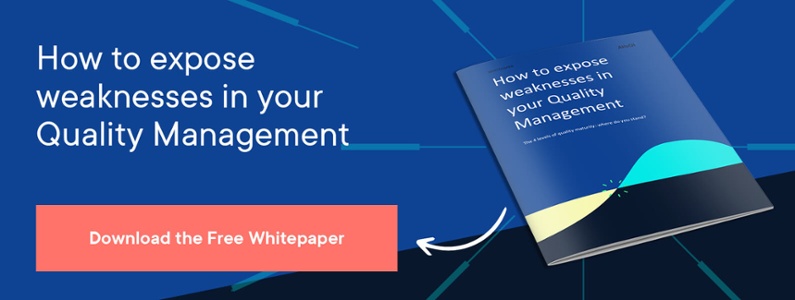Solvers help you monitor quality, apply SPC, manage equipment, and ensure traceability.

What should you look for in a Quality Management solution?
Just as Process Maturity should be built around a 360° approach, your means of getting there should be holistic too, and not piecemeal.
Quality professionals know better than most people that opinions, reviews, anecdotes, and even experiences are not the same as KPIs.
Amazon uses subjective customer reviews as part of its algorithms to determine product rankings, but the digital giant has millions of customers which gives its methodology a kind of statistical sheen.
But it remains hit and miss. How often have you been to a restaurant that had been glowingly reviewed in Tripadvisor, only to go home disappointed (or hungry)? Or struggled to stay awake during a film, usually a ‘serious’ one, that had been praised by every well-respected critic?

If your product falls consistently below a certain standard, customers will call you out on it, but quality can never base itself on word of mouth. Quality management really is underpinned by statistics – by rigorous likelihoods that a meal or a movie will live up to expectations, or that your adapters don’t break open and risk electrocuting your customers, as it happened with Apple recently.
An objective view of where you are
If you want to know how well you manage your quality processes, you need to inoculate the way you do this against subjectivity as much as you can. You can’t succeed completely. Factory workers, laboratory technicians, engineers, and senior management aren’t products or batches that can be scientifically – that is to say, objectively – measured. And an opinion that runs counter to yours is not a deviation to be thrown out and re-manufactured. Actually, you want to see deviations because a survey that elicits identical replies from people in very different jobs and with very different vantage points is worthless.
Our Quality Intelligence Maturity Matrix does not pretend to be scientific. If there is any statistical method, it is our decision to make it as approachable as possible because there’s safety in numbers. If everyone in your manufacturing company completes the grid, you are more likely to get the kind of insights that will help you shape and prioritize your next steps in raising quality management standards.
Getting results out of results
So what do these next steps look like? Very few, if any, manufacturers will run completely ad hoc and isolated quality processes but you could say this would simplify your strategy going forward: to barrage the boardroom with requests for a quality management solution and resign if you don’t get your way.
Let’s hope it won’t come to that.
However, in the vast majority of cases, the picture will be mixed, and you are judged to be performing well in some aspects, but fall short in others. This can happen when a manufacturer has already implemented a solution to integrate and automate parts of Quality Control, most commonly through a Laboratory Information Management Systems or LIMS. What are your next steps?
The diagnosis will be: our Document Management and QESH processes are not on a par with how we run quality management. And the proposed remedy might be: we get licenses for a Document Management and a QESH tool, and integrate them into our day-to-day processes.
But bolting on another set of tools and functionalities is integration by the backdoor and one that maintains the siloed thinking that is holding back so many quality teams. You want Quality Control, Document Management, and QESH to be so interconnected and inter-permeated as to make the distinctions between them meaningless in practice.
Don’t compromise on integration
This was the situation that confronted a medium-sized Dutch manufacturer, owned partly by the chemicals giant Akzo Nobel. A leading producer of ethyleneamines, the company had put its Quality Control on a sound footing by implementing a LIMS tool. But management recognized that to reach Quality Maturity, and prepare for the technologies of tomorrow, it needed every aspect of quality management to be smart and integrated.
The LIMS module came from AlisQI and the manufacturer was completely satisfied with it. But that is (and was) beside the point. What is so instructive is that the quality leader tasked with the project of advancing quality management maturity was told explicitly that the very positive experience with the AlisQI Quality Control/LIMS module could not play a role in the selection of an integrated system. And this was absolutely the right decision: the success of an integrated system cannot depend on the effectiveness of just one component.
You will forgive us if we add that, in the end, AlisQI was selected because its Quality Management Platform as a whole satisfied the manufacturer’s criteria.
So what does holistic and integrated quality management look like? Quality Control and QESH forms link directly to the relevant documents in the internal Document Management System. Process flow charts in Document Management link directly to QC and QESH forms. Actions and events for QC, QESH, and Document Management are grouped on one integrated action list, one integrated internal calendar. Your KPI dashboards show details from QC, QESH, and Document Management.
From silos to seamlessness: this should be what a quality management solution ought to deliver.
How mature is your quality management?
In this era of smart manufacturing, quality will become smart as well. This transition will not happen overnight and this will not happen in a linear way. Our Quality Intelligence Maturity Model presents a springboard to change and asks organizations to self-assess to what extent they are ready for Quality Intelligence and to leverage tomorrow’s possibilities.
The Quality Maturity Model is designed to highlight the strengths and expose potential weaknesses of all aspects of your quality management, giving you the input necessary to strategize for positive change.


